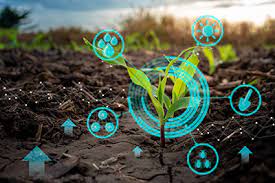Reliable weather information is vital to the success of any farm. Weather stations allow farmers and ranchers alike to access accurate site-specific data, which can be used for to effective and smart agricultural decision-making.
1. Anemometer: An anemometer is used to measure wind speed. The word comes from the Greek word anemos, meaning wind, and meter, which indicates the speed of moving objects.
2. Rain Gauge: Measures the amount of precipitation by using an open container. It usually empties automatically, measures the amount of rainfall over a given time interval, and has an alarm system to alert you when it’s out of water.
3. Barometer: A barometer is a tool to measure the pressure of the atmospheric air.
Generally, it is made up of a glass tube closed at one end with a bulb containing mercury at the other end.
4. Hygrometer: A hygrometer is a device used to measure humidity or the amount of moisture in the air.
5. Thermometer: Measures the atmospheric temperature.
6. Pyranometer: Otherwise known as solar irradiance, this measures the power of the light and heat from the sun.
3 Helpful Sensors for Agriculture

Now that you know how weather meters work in agriculture, let’s talk about several sensors that are beneficial.
1. Leaf Wetness Sensor: Measure the moisture of your plants digitally. One way to measure moisture is through sensors, which can be installed on a scale of dry to saturated. These sensors are important for fungal disease control. A moisture sensor measures the wetness of dirt and uses this reading to help control fungal disease. The reading is on a scale of 0-15, where 0 is dry and 15 is saturated.
2. Soil Moisture Sensor: Sensors installed in your irrigation system can measure the current moisture level of the soil. This helps you better supply and distribute water for optimum plant growth. By using sensors, you reduce the risk of over-or under-watering. Soil moisture may also give clues in terms of how upcoming crops will turn out.
3. Soil Temperature Sensor: The soil temperature sensor can detect freezing or high temperatures, which are both major threats to crops. It also calculates the rate of evapotranspiration in plants.
Kestrel Weather Stations for Agriculture
Curious about how weather stations can improve planting, harvesting, irrigation, and much more? The KestrelMet 6000 AG Weather Station is an excellent choice for a comprehensive, all-in-one, on-farm weather station. Starting at $1299 for the weather station with all standard meteorological measurements (wind, temperature, humidity, rainfall, and more) you can choose to add on sensors for leaf wetness, soil moisture and soil temperature, and solar radiation based on farming needs. This model is a cellular weather station making it ideal for large farms and rural locations where Wi-Fi can prove unreliable.
For monitoring weather conditions prior to pesticide application, Kestrel Instruments has handheld weather meters that give you field-level measurements right at the crop with the ability to log spraying conditions. The 3550AG Weather Meter for Spray Applications measures wind speed and wind direction in addition to temperature, humidity, and Delta T. It also comes with Bluetooth to use with the Kestrel LiNK companion app making it easy to instantly capture and log weather data with just one-click. The 5500AG Weather Meter offers even more measurements for use in spraying and around the farm for monitoring livestock heat stress and barn/housing ventilation. It measures wind speed, direction, wind chill, temperature, relative humidity, Delta T, THI (temperature-humidity index) and more.

